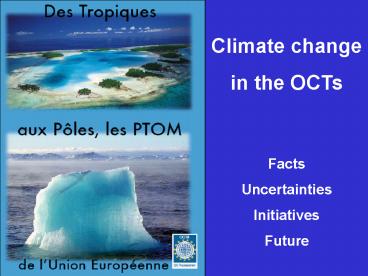Prsentation PowerPoint - PowerPoint PPT Presentation
1 / 10
Title:
Prsentation PowerPoint
Description:
'How inappropriate to call this planet Earth when it is quite ... Total EEZ of the inhabited OCTs = 11 495 415 km = 3,08% of the global surface of the Oceans ... – PowerPoint PPT presentation
Number of Views:51
Avg rating:3.0/5.0
Title: Prsentation PowerPoint
1
Tuuhia Vaia
Tuuhia Vaia
Climate change in the OCTs Facts Uncertainties
Initiatives Future
2
Oceans, common references for the OCTs
How inappropriate to call this planet Earth when
it is quite clearly Ocean attributed to Arthur
C. Clarke from the European Maritime Policy
Paper 2006
Global circulation of water OCTs
- OCTs 16 islands located in
- North Atlantic Ocean
- South Atlantic Ocean
- Caraibean See
- Indian Ocean
- Pacific Ocean
Total EEZ of the inhabited OCTs 11 495 415 km
² gt 3,08 of the global surface of the Oceans
EEZ of the European Community 8 099 463 km²
2,17 of the global surface of the Oceans
3
Impacts of climate change and heating of the
oceans
- From the poles
- Ice melting
- 2005 the lowest ice extent ever measured
- Stratification of the ocean and carbon storage
- to the tropics
- The energy of hurricanes has increased both in
the Atlantic and Pacific, to their highest values
- Coral reef bleaching
- Ocean acidification, methanisation
4
Sea level rise and the vulnerability of islands
- The vulnerability of islands and littorals was
recognized by the United Nation resolution
44/206, 1989 - Current and significant effects
- Inundation
- Erosion
- Increased wave activity
- Saline intrusion
- Pressure of urbanisation
- As population, agricultural land and
infrastructure of OCTs tend to be concentrated in
the coastal zone, any rise in sealevel will have
significant and profound effects on their
economies and living conditions
5
Climate change and environemental catastrophy
- Intensity of Hurricanes
- Floods, precipitation, landslide
- Perception of the risks by the inhabitants
- Refugees as a result of sea-level rise
- While OCT are among those that contribute least
to global climate change, they are among those
that would suffer most from the adverse effects
such phenomena and could in some cases become
uninhabitable
Aruba
Turk Caicos
6
Initiatives taken by the OCTs
- Reducing carbon emission
- Strenghtening institution
- Coastal management
- Risks prevention
- Raising awarness
- Promoting research and initiatives for
sustainability
There is already enough understanding to know
what the main causes of climate change are and
how to reduce future climate change Further
knowledge is needed to tackle the challenges and
make appropriate and urgent decisions to begin to
adapt
7
Adaptation for a sustainable development
- to support mitigation projects in OCTs
- to define the local and regional capacities of
adaptation - to enhance conclusive scientific research in the
OCTs, to support, with estimations and data,
decision makers who will be able to better
estimate precaution principle - to develop research capacity building and
knowledge management network - to match scientific and traditonal knowledge to
ensure the transmission - It is strongly necessary to provide OCTS with
capacity building aim to implement adaptation
projects
8
A call for urgent measures to avoid a climatic
catastrophy
9
Thank you
Other Sources and biblography Sea Around Us
Project (December 2005), University of British
Columbia, CIA Year Factbook,Foreign and
Commonwealth OfficeForeign and Commonwealth
Office http//europa.eu.int/scadplus/leg/en/lvb/r1
2300.htm The Future Oceans Warming Up, Rising
High, Turning Sour - German Advisory Council on
Global Change (WBGU) January 2006 Impacts du
Réchauffement climatique sur les petites îles du
Pacifique, modélisation et perception du risque,
un projet du Ministère de lOutre-mer, réalisé
par les laboratoires PRODIG, (CNRS) et IRIDIP,
unité de recherche au sein de luniversité de la
Polynésie française Bilan 2001 des changements
climatiques Conséquences, adaptation et
vulnérabilité - Rapport du Groupe de travail II
du GIEC OMM PNUE Bilan 2001 des changements
climatiques Mesures datténuation - Rapport du
Groupe de travail III du GIEC OMM PNUE
10
Risk and coastal management
- Case study in Faaa (agglomeration of Papeete)
- Simulation if sea rises of 80 cm (IPCC scenario)
1 Faaa, modelisation of a rise of 80 cm
0 Faaa, initial level
0,80 m
Even the inundation of a limited area represent
the destruction of existing economic
infrastructure as well as of existing human
settlements. Loss of exclusive economic rights.































